“White gold” story: Preserving salt-making in Nam Dinh province
Salt-making in Bach Long commune, northern Nam Dinh province’s Giao Thuy district, is now standing on the edge of oblivion. Local salt-makers are struggling to earn their living with their trade.
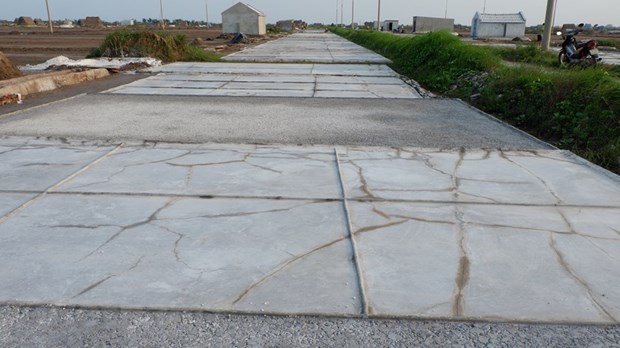 Salt fields in Bach Long have been known as the biggest in northern Vietnam, covering up to 230 hectares. Salt-making has been the pride of local residents. It has supported locals in the coastal commune since the community was first set up in 1965. But it’s a hard life, with workers labouring under the hot sun from dawn to dusk. It cannot describe their hardships, only when you try to work on the salt field, you just understand the value of pure white salt grains made. The time from March to August every year is the season for salt making of Bach Long farmers. (Photo: VietnamPlus)
Salt fields in Bach Long have been known as the biggest in northern Vietnam, covering up to 230 hectares. Salt-making has been the pride of local residents. It has supported locals in the coastal commune since the community was first set up in 1965. But it’s a hard life, with workers labouring under the hot sun from dawn to dusk. It cannot describe their hardships, only when you try to work on the salt field, you just understand the value of pure white salt grains made. The time from March to August every year is the season for salt making of Bach Long farmers. (Photo: VietnamPlus)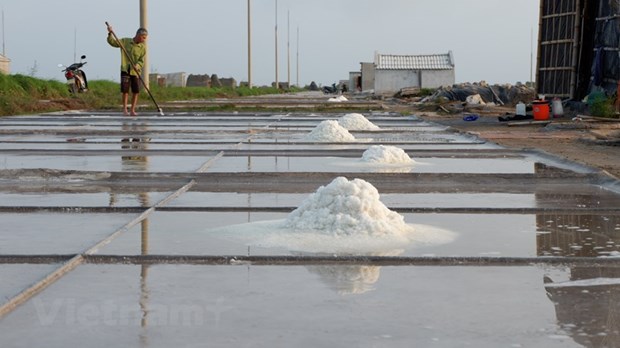 Traditionally, salt-making involves a lot of physical work with hand-made tools from natural materials like bamboo and straw ash. The system is simple but effective. Sea water is channelled to the salt fields, which look like a chessboard. The water is left to sit in an area lined with sand which salt-makers stur regularly to ensure thorough absorption. Once the water has evaporated, more sea water is added and the mixture is strained through bamboo filters into an area lined with a hardened mixture of slaked lime and straw ash, post-harvest products, and left to dry. If the weather is hot, farmers can harvest salt at 5pm and bring to their stores. But if it rains, the whole process has to be abandoned. (Photo: VietnamPlus)
Traditionally, salt-making involves a lot of physical work with hand-made tools from natural materials like bamboo and straw ash. The system is simple but effective. Sea water is channelled to the salt fields, which look like a chessboard. The water is left to sit in an area lined with sand which salt-makers stur regularly to ensure thorough absorption. Once the water has evaporated, more sea water is added and the mixture is strained through bamboo filters into an area lined with a hardened mixture of slaked lime and straw ash, post-harvest products, and left to dry. If the weather is hot, farmers can harvest salt at 5pm and bring to their stores. But if it rains, the whole process has to be abandoned. (Photo: VietnamPlus) Local salt farmers rise before dawn as they have for generations, fanning out across shallow seawater pools to harvest the precious mineral. The work is punishing and the incomes unstable, subject to seesawing demand swayed by foreign imports, and increasingly unpredictable weather patterns. Locals spend a large part of their lives working in the salt fields, wearing conical hats and ferrying mountains of the saline crystals in bamboo baskets along reflective ponds against a setting sun. They shuffle carefully along narrow ledges separating the rectangular plots that are pumped full of salty seawater. Farmers say life is tough on the fields where they toil during the annual harvesting season from March to August. (Photo: VietnamPlus)
Local salt farmers rise before dawn as they have for generations, fanning out across shallow seawater pools to harvest the precious mineral. The work is punishing and the incomes unstable, subject to seesawing demand swayed by foreign imports, and increasingly unpredictable weather patterns. Locals spend a large part of their lives working in the salt fields, wearing conical hats and ferrying mountains of the saline crystals in bamboo baskets along reflective ponds against a setting sun. They shuffle carefully along narrow ledges separating the rectangular plots that are pumped full of salty seawater. Farmers say life is tough on the fields where they toil during the annual harvesting season from March to August. (Photo: VietnamPlus) 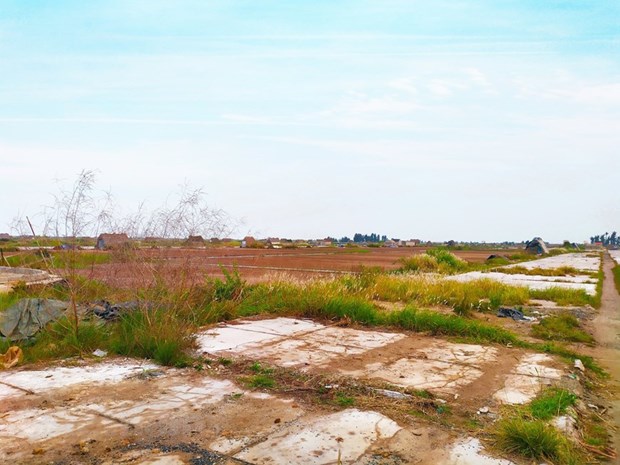 Over the past years, salt production in the northern province of Nam Dinh has significantly declined to a large extent as many salt workers have quit their job. There are two main reasons for this drastic decline in salt output: unfavourable weather conditions and late harvest time. Moreover, at a daily income of merely 50,000 VND (2.19 USD) in case of favourable weather conditions, it is no wonder that many locals have given up this job and become bricklayers etc., for a much higher one. Consequently, local authorities have been deploying various methods to motivate farmers to stay on this job. (Photo: VietnamPlus)
Over the past years, salt production in the northern province of Nam Dinh has significantly declined to a large extent as many salt workers have quit their job. There are two main reasons for this drastic decline in salt output: unfavourable weather conditions and late harvest time. Moreover, at a daily income of merely 50,000 VND (2.19 USD) in case of favourable weather conditions, it is no wonder that many locals have given up this job and become bricklayers etc., for a much higher one. Consequently, local authorities have been deploying various methods to motivate farmers to stay on this job. (Photo: VietnamPlus) 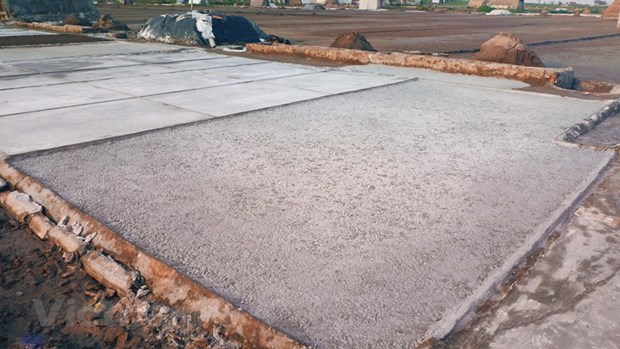 Bach Long commune has a long history of making salt. Yet, in the past few years, the area of salt fields has fallen to nearly 60ha as farmers have quit the tough and low-paid work. Many of them become bricklayers or plant vegetables and raise fish. Now, mainly women, old men and those too weak to fish offshore work on the salt fields. According to locals, there is enough bright sunlight to work in the salt fields for only about five months a year. The work depends much on the weather, while the salt price often fluctuates, leading to unstable lives for salt makers. (Photo: VietnamPlus)
Bach Long commune has a long history of making salt. Yet, in the past few years, the area of salt fields has fallen to nearly 60ha as farmers have quit the tough and low-paid work. Many of them become bricklayers or plant vegetables and raise fish. Now, mainly women, old men and those too weak to fish offshore work on the salt fields. According to locals, there is enough bright sunlight to work in the salt fields for only about five months a year. The work depends much on the weather, while the salt price often fluctuates, leading to unstable lives for salt makers. (Photo: VietnamPlus)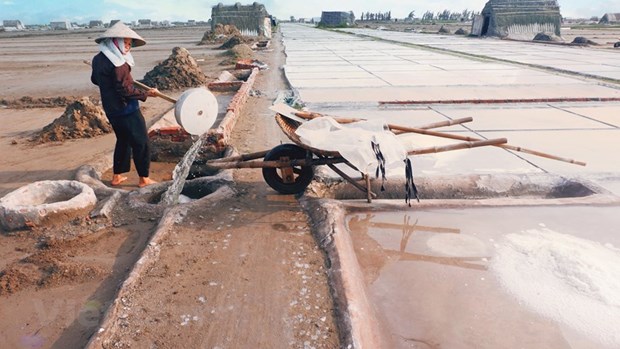 Local authorities are deploying various methods to motivate workers to stay on this job. According to Pham Van Quang, Vice Chairman of the Bach Long commune People’s Committee, to support local salt makers and preserve the job, they have put forth a salt production planning scheme under which the areas with low production efficiency will receive investments to shift to crop planting, husbandry and aquaculture. Meanwhile, the locality has set a target of producing 10,000 tonnes of salt each year and encouraged the operation of clean salt production facilities. Currently, the commune counts 30 units and companies engaging in salt production. (Photo: VietnamPlus)
Local authorities are deploying various methods to motivate workers to stay on this job. According to Pham Van Quang, Vice Chairman of the Bach Long commune People’s Committee, to support local salt makers and preserve the job, they have put forth a salt production planning scheme under which the areas with low production efficiency will receive investments to shift to crop planting, husbandry and aquaculture. Meanwhile, the locality has set a target of producing 10,000 tonnes of salt each year and encouraged the operation of clean salt production facilities. Currently, the commune counts 30 units and companies engaging in salt production. (Photo: VietnamPlus)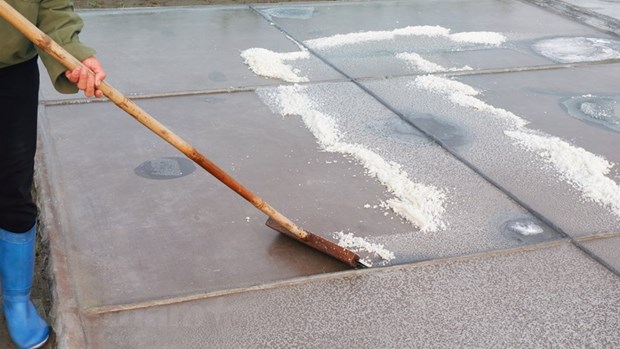 Salt is currently produced in 21 coastal provinces across the country. According to the Ministry of Agriculture and Rural Development, salt farming area totaled 13,600 hectares in April 2019. The Government has approved a salt industry development project for 2021-2030. Under the project, Vietnam will combine salt production with tourism in villages including Thy Hai (Thai Bình province), Bach Long (Nam Dinh), Ho Do, Ky Ha – Hy Anh (Ha Tinh), Sa Huynh (Quang Ngai), Hon Khoi (Khanh Hoa), and Can Gio (Ho Chi Minh City). The project aims to develop the salt industry towards efficiency and sustainability, based on the advantages of localities. (Photo: VietnamPlus)
Salt is currently produced in 21 coastal provinces across the country. According to the Ministry of Agriculture and Rural Development, salt farming area totaled 13,600 hectares in April 2019. The Government has approved a salt industry development project for 2021-2030. Under the project, Vietnam will combine salt production with tourism in villages including Thy Hai (Thai Bình province), Bach Long (Nam Dinh), Ho Do, Ky Ha – Hy Anh (Ha Tinh), Sa Huynh (Quang Ngai), Hon Khoi (Khanh Hoa), and Can Gio (Ho Chi Minh City). The project aims to develop the salt industry towards efficiency and sustainability, based on the advantages of localities. (Photo: VietnamPlus)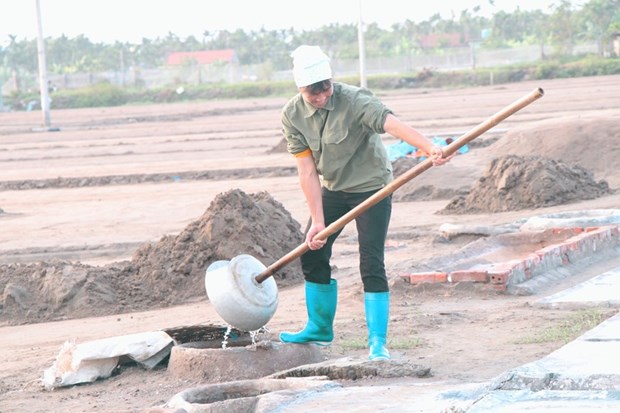 Vietnam expects to have 14,500 hectares of salt farming with an output of 1.5 million tonnes per year by 2025. In the next five years, the focus will be on producing salt to meet domestic demand with healthy natural minerals and micronutrients with low NaCl content. The total salt farming is targeted to drop to 14,244 hectares by 2030 but the annual output is hoped to increase to 2 million tonnes. Salt production will be developed on an industrial scale in Khanh Hoa, Ninh Thuan and Binh Thuan provinces to meet the demand of the chemical industry and for raw materials to produce refined salt. (Photo: VietnamPlus)
Vietnam expects to have 14,500 hectares of salt farming with an output of 1.5 million tonnes per year by 2025. In the next five years, the focus will be on producing salt to meet domestic demand with healthy natural minerals and micronutrients with low NaCl content. The total salt farming is targeted to drop to 14,244 hectares by 2030 but the annual output is hoped to increase to 2 million tonnes. Salt production will be developed on an industrial scale in Khanh Hoa, Ninh Thuan and Binh Thuan provinces to meet the demand of the chemical industry and for raw materials to produce refined salt. (Photo: VietnamPlus)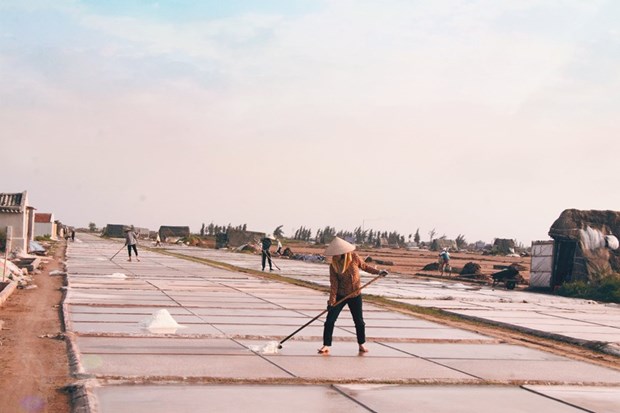 Meanwhile, smaller-scale production will be developed in Thai Binh, Nam Dinh, Thanh Hoa, Nghe An, Ha Tinh, Quang Ngai, Phu Yen, Binh Dinh, Ba Ria-Vung Tau, Ho Chi Minh City, Ben Tre, Tra Vinh, Soc Trang, Bac Lieu and Ca Mau. Support will be provided to develop supply chains for the salt industry. The project will also focus on applying science and technology in salt production and processing to minimise climate change’s impacts. Trade promotions will be increased to export salt products. Through such solutions, Vietnam expects to have 14,500 hectares of salt farming with an output of 1.5 million tonnes per year by 2025. (Photo: VietnamPlus)
Meanwhile, smaller-scale production will be developed in Thai Binh, Nam Dinh, Thanh Hoa, Nghe An, Ha Tinh, Quang Ngai, Phu Yen, Binh Dinh, Ba Ria-Vung Tau, Ho Chi Minh City, Ben Tre, Tra Vinh, Soc Trang, Bac Lieu and Ca Mau. Support will be provided to develop supply chains for the salt industry. The project will also focus on applying science and technology in salt production and processing to minimise climate change’s impacts. Trade promotions will be increased to export salt products. Through such solutions, Vietnam expects to have 14,500 hectares of salt farming with an output of 1.5 million tonnes per year by 2025. (Photo: VietnamPlus)  The scheme also expects to pilot models where salt making and tourism are combined in traditional salt-making villages for salt processing, marketing and sale in salt fields such as Thuy Hai in Thai Binh province, Bach Long in Nam Dinh province, and Ho Do and Ky Ha-Ky Anh in Ha Tinh province. Trade promotion and brand building for the export of salt in Thai Binh, Nam Dinh, Nghe An, and Ha Tinh provinces are also part of the scheme. Salt is currently produced in 21 coastal provinces nationwide. According to the Ministry of Agriculture and Rural Development, salt farming area totaled 13,600 hectares in April 2019. (Photo: VietnamPlus)
The scheme also expects to pilot models where salt making and tourism are combined in traditional salt-making villages for salt processing, marketing and sale in salt fields such as Thuy Hai in Thai Binh province, Bach Long in Nam Dinh province, and Ho Do and Ky Ha-Ky Anh in Ha Tinh province. Trade promotion and brand building for the export of salt in Thai Binh, Nam Dinh, Nghe An, and Ha Tinh provinces are also part of the scheme. Salt is currently produced in 21 coastal provinces nationwide. According to the Ministry of Agriculture and Rural Development, salt farming area totaled 13,600 hectares in April 2019. (Photo: VietnamPlus)












